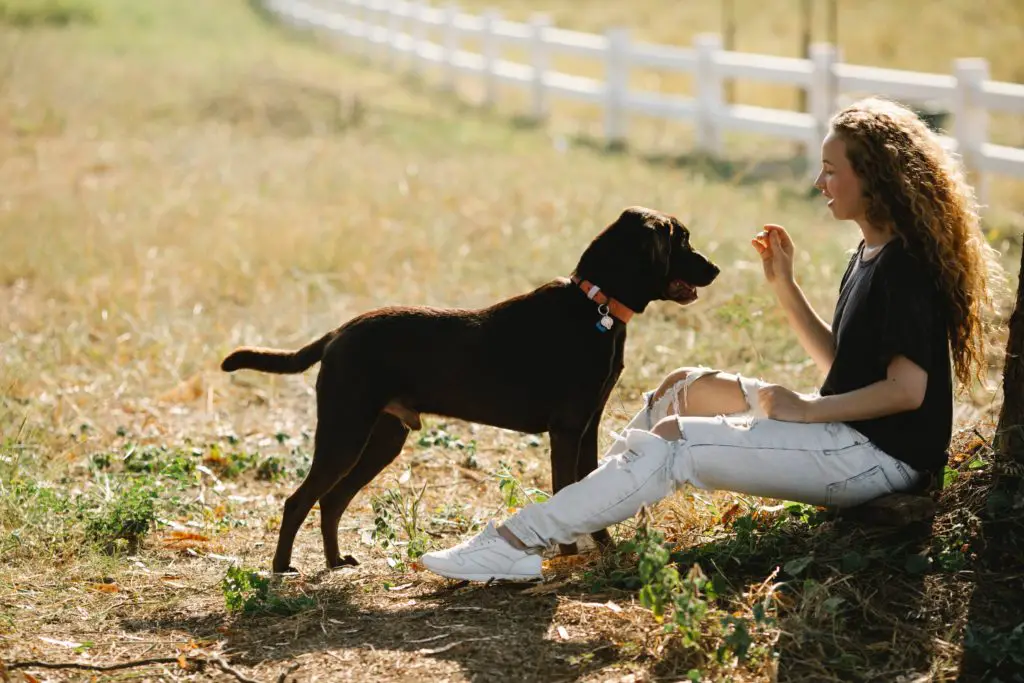Dogs that are born without hearing or lose their hearing are just as apt to bark as a hearing a dog. There are many reasons a deaf dog may bark; one reason is out of frustration. Barking is one of the ways they are able to communicate with the world.
Other reasons for a deaf dog barking could include anxiousness or being fearful. Some dogs regardless if they can hear will bark at neighbors, unknown objects, and even a squirrel in a tree. Learning how to train a deaf dog to stop barking will build confidence in the dog and offer your dog other ways to communicate.
It is good to keep in mind that learning how to train a deaf dog to stop barking is very similar to teaching a hearing dog. The biggest difference is using hand signals instead of verbal signals when communicating with your deaf dog.
Before you begin training, know what triggers your dog to bark, be prepared with tasty rewards and plan on being consistent with implementing the training methods.
Related Articles:
- How to Train a Dog
- How to Crate Train a Dog
- How to Leash Train Your Dog
- How to Clicker Train Your Dog
- How to Obedience Train Your Dog
How to Train a Deaf Dog to Stop Barking: What Triggers the Barking
The top triggers for deaf dogs are boredom, fearfulness, anxiousness, or anxiety associated with separation. Other reasons could be as simple as wanting to get your attention, they are excited, or they were surprised by something in the environment.
A dog barking is normal and expected when we invite them into our life. However, nonstop, or fearful barking can be annoying for us and build up frustration or anxiousness in the dog. Besides their body language, barking is a way for them to communicate with us.
A dog that is “excited barking” will often be wagging their tail, have loose body language and they might even spin circles. Deaf dogs that bark to get our attention will often bark, stop, look in their owner’s direction, bark again, and repeat.
Other times your dog might bark to get your attention is they want you to share your snack or engage in playtime. The telltale body language in this case is possible drooling while looking at you and your snack. Your dog expresses a playbow in front of you and wants to play ball or tug.
Related Articles:
- Ultimate Guide: How To Take Care Of A Puppy
- Ultimate Guide: How To Take Care Of A Dog
- Ultimate Guide: How To Take Care Of A Senior Dog
- The Benefits of Owning a Dog
- Top 12 Tips for First Time Dog Owners
- How to Train a Dog

How to Train a Deaf Dog to Stop Barking: Trigger Method
For this particular method, you will need tasty treats for rewarding your dog, a small flashlight (not a laser light), a leash, and if possible, a friend to assist you.
- Simulate. Your friend or assistant will simulate one the triggers that gets your dog barking. One way is having the person come to your door or walking by your window outdoors, which surprises or excites your dog.
- Introduce Light & Reward. When your dog begins to bark, wait for the smallest pause in the barking, and then signal them with a flash of light at their feet and treat your dog. Repeat.
- Hand Sign for Stop. Practicing this exercise for a few days until your dog is understanding that when they stop barking, see a flash of light, they get a tasty reward. Next, you will use the hand sign for stop after the flash of light.
- Practice & Reinforce. You will continue to use the light to get their attention while barking and follow it with the sign for “stop”. Continue practicing over the course of the following weeks or months. When the dog is able to see you the flash of light it can be omitted, and you can use the sign for stop.
Dog owners with a deaf dog often use The American Sign Language signs. The sign for “stop” is made by extending your left land with the palm facing upward. Take your right hand and bring it down quickly on your left land at a right angle.
The trigger method is an effective way to learn how to train a deaf dog to stop barking.
Relevant Articles:
- How to Train Your Dog to be Social
- Top 5 Basic Dog Training Commands
- How to Train Your Dog to Walk on a Leash
- How to Train Your Dog with Positive Reinforcement
- How to Potty Train an Older Dog in an Apartment
How to Train a Deaf Dog to Stop Barking: Vibration Collar
Another method for teaching a deaf dog to stop barking is using a vibration collar. These collars are designed to give a gentle vibration feeling around the dog’s neck. For clarification, these collars are not the same as an electronic shock collar.
The vibration collar method is designed to get the dog’s attention and direct them to you. You can offer them a command through signs and rewards to reinforce correct behaviors.
- The Collar. Fit your dog with a vibration collar and reward them. Some dogs will need an adjustment time of putting the collar on and getting a reward. This is very similar to introducing a puppy to wearing a collar.
- Use Vibration. When your dog begins to bark, give them a vibration signal through the collar.
- Introduce Sign for Stop. Once you have your dog’s attention, by using the vibration collar, you can give them hand sign for “stop”. Reward your dog immediately.
- Reinforce behavior. Continue with using the vibration collar. Your dog will begin to see the pattern of when bark they get a vibration. Vibrations signify looking at you. You will give the sign for “stop” and follow up with a reward.
- Use Vibration and Sign. Eventually your dog will learn that a reward comes when they stop barking. After weeks or months, you could move to just using the sign for “stop”.
Many dog owners use a vibration collar to get their deaf dog’s attention. The use of vibration collar to learn how to train a deaf dog to stop barking is a convenient method.
Relevant Articles:
- How to Get the Attention of a Deaf Dog
- How to Train a Deaf Dog to Sit and Stay
- How to Train a Deaf Dog with Hand Signals
- How to Train a Deaf Dog
- How to Potty Train a Deaf Dog

How to Train a Deaf Dog to Stop Barking: Redirect
One method of training that many dog owners use as an effective tool to teach how to train a deaf dog to stop barking is redirecting your dog. This method pairs well with bossy barking often associated with begging or wanting attention.
You will need a friend to assist, a dog bed (or special location), a leash, and tasty rewards.
- Designate a Location. Establish a location in your home that is familiar to your dog. It is helpful if they know the sign for that location as well. You can use a dog crate, dog bed, or even a designated rug in your home.
- Simulate for Practice. Simulate a situation where your dog might bark to get your attention. Get your dog’s attention with either a hand signal or a vibration collar.
- Redirect dog. Once you have your dog’s attention, lead them over to the designated location. If your dog knows the hand sign for “bed” or “crate” you can use that in place of the leash. Reward your dog with a food stuffed toy, chew toy or tasty reward.
- Practice. You will repeat by redirecting your dog when you want them to stop barking. Direct them to their designated location, reward them with a problem solving toy or a treat.
Redirecting your dog when they are barking can be a peaceful and reassuring method to learning how to train a deaf dog to stop barking.
It is always good to remember that deaf dogs might not hear but they still have their sight, smell, and touch. Dog owners use their dog’s other senses to train and teach new behaviors. If your dog becomes overly stressed from separation anxiety, it is always best to address that issue and adjust your training methods to meet the need.
When learning how to train a deaf dog to stop barking, know what causes the barking and practice one of the above-mentioned solutions. Many dog owners use all three methods for teaching their dog to stop barking; the trigger light method, vibration collar, and redirecting their dog to stop barking.

Relevant Articles:
- How to Cook Marrow Bones for Dogs
- How to Measure a Dog for a Harness
- Top 12 Tips for First Time Dog Owners
- How to Stop a Dog from Pooping in the House at Night
Please read our Legal Disclaimer

